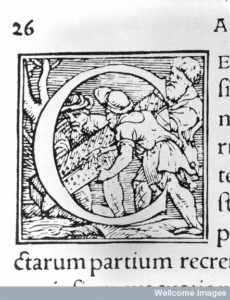by Helen King (monthly contributor)
I was recently talking to a breakfast group about ‘Bodies, ancient and modern’. No, I don’t know why they wanted to hear about bodies at breakfast, either – I prefer to focus on my muesli. In the section in which I talked about the history of gaining knowledge of the body, I showed a slide of one of Gunther von Hagens’ plastinated corpses, and I made the point that – although what you are seeing is a real body, treated after death to preserve it – they end up looking a lot more dry and hence ‘unreal’ than the wax images of the eighteenth century. Von Hagens is known in the media as ‘Dr Death‘ and his bodies do, indeed, look very dead, regardless of the lifelike and active poses in which they end up. Interesting questions about ‘reality’ and art are raised by this. When you consider a wax image, the colors and the shine of the wax give a far more ‘wet’ and thus ‘real’ impression than any real but subsequently plastinated body.
Many years ago, I taught a few sessions on an MA degree, ‘Death and Society’, set up by Tony Walter. It was an interesting course, taken by a number of funeral directors as professional development, as well as by others from all walks of life. I taught them how cadavers were treated in the early modern period in order to ‘make’ skeletons for teaching purposes. Illustrated here in one of Vesalius’s capital letters from Fabrica (1543), you can see one stage, in which the corpse was treated with quicklime and then that was washed off by placing the coffin, pierced with holes, in a river. You can see the corpse’s hand coming out from under the lid…
At the end of one year’s course, in 2002, I was invited on the official course outing. This had two parts. First, we went to von Hagens’ Bodyworlds exhibition, then on display in East London. I admit, I was in two minds about this. It’s one thing looking at representations of bodies, even flayed or dissected ones – but quite another to gaze at a body and know it was once a living person who at some point donated his or her mortal remains to be treated and displayed. Here, I’m glossing over the claims that not all of the bodies one sees in the exhibition came by that route, claims which add their own spice to the experience, as they recall the history of body-snatching in the production of anatomical knowledge.
The people going round the exhibition were a mix of ages and backgrounds. Some brought along their children or partners, in some cases because one of them was in a medical job and wanted the other to see what it’s all about. Some came because of a particular personal experience; I watched one woman talk another through the display of damaged and replacement hip joints, sharing what had happened to her. Being with the MA group, which included archaeologists, gave me an extra dimension, as they pointed out to me that von Hagens’ focus was on muscles, and his treatment of bones was often less careful and left sharp edges visible.
I was doing absolutely fine until I came face to face with a representation of a man carrying his own skin. No, wait, let’s get this right: with a real human body posed with his skin. This is an image used by Vesalius, and seeing real bodies in poses deliberately recalling iconic images of the history of medicine is enough to make anyone confused about where the boundaries lie! But in this case, a further disorienting factor was the soles of the feet. Somehow, those were very personal, a vivid reminder of just what I was really looking at.
And then we had lunch. I wasn’t as hungry as usual. For the second part of the outing, we went to a London funeral parlor. Including the mortuary and the embalming room.
![By Nick Webb from London, United Kingdom (Skin) [CC BY 2.0 (http://creativecommons.org/licenses/by/2.0)], via Wikimedia Commons](https://www.wondersandmarvels.com/wp-content/uploads/2016/05/Skin_2969103184-159x300.jpg)
By Nick Webb from London, United Kingdom (Skin) [CC BY 2.0 (http://creativecommons.org/licenses/by/2.0)], via Wikimedia Commons
And do you know what? It was nowhere near as disturbing as the soles of that man’s feet.

